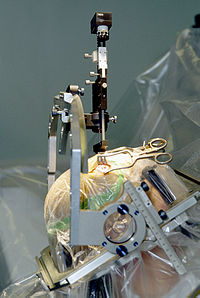
Photo from wikipedia
Purpose: To propose a novel, radiation-free method for postoperative three-dimensional (3D) position analysis of dental implants based on the dynamic navigation system (DNS) and evaluate its accuracy in vitro. Methods:… Click to show full abstract
Purpose: To propose a novel, radiation-free method for postoperative three-dimensional (3D) position analysis of dental implants based on the dynamic navigation system (DNS) and evaluate its accuracy in vitro. Methods: A total of 60 implants were digitally planned and then placed in the standardized plastic models with a single-tooth gap and a free-end gap under the guidance of the DNS. Postoperative 3D positions of the inserted implants were evaluated using specially designed navigation-based software, and its datasets were superimposed onto those of cone beam computed tomography (CBCT) for accuracy analyses. Deviations at the coronal, apical, and angular levels were measured and statistically analyzed. Results: The mean 3D deviation was 0.88 ± 0.37 mm at the entry point and 1.02 ± 0.35 mm at the apex point. The mean angular deviation was 1.83 ± 0.79 degrees. No significant differences were noted in the deviations between implants placed in the single-tooth gap and the free-end situation (p > 0.05) or between different tooth positions at distal extensions (p > 0.05). Conclusions: This non-radiographic method provides facile, efficient, and reliable postoperative implant position evaluation and may be a potential substitute for CBCT, particularly for implants placed under the guidance of dynamic navigation.
Journal Title: Journal of Personalized Medicine
Year Published: 2023
Link to full text (if available)
Share on Social Media: Sign Up to like & get
recommendations!